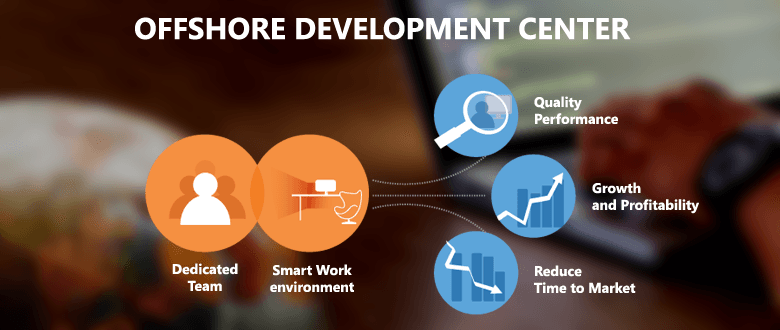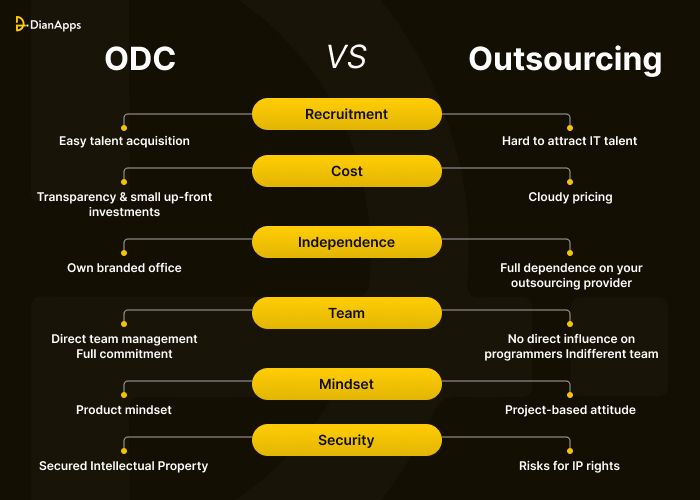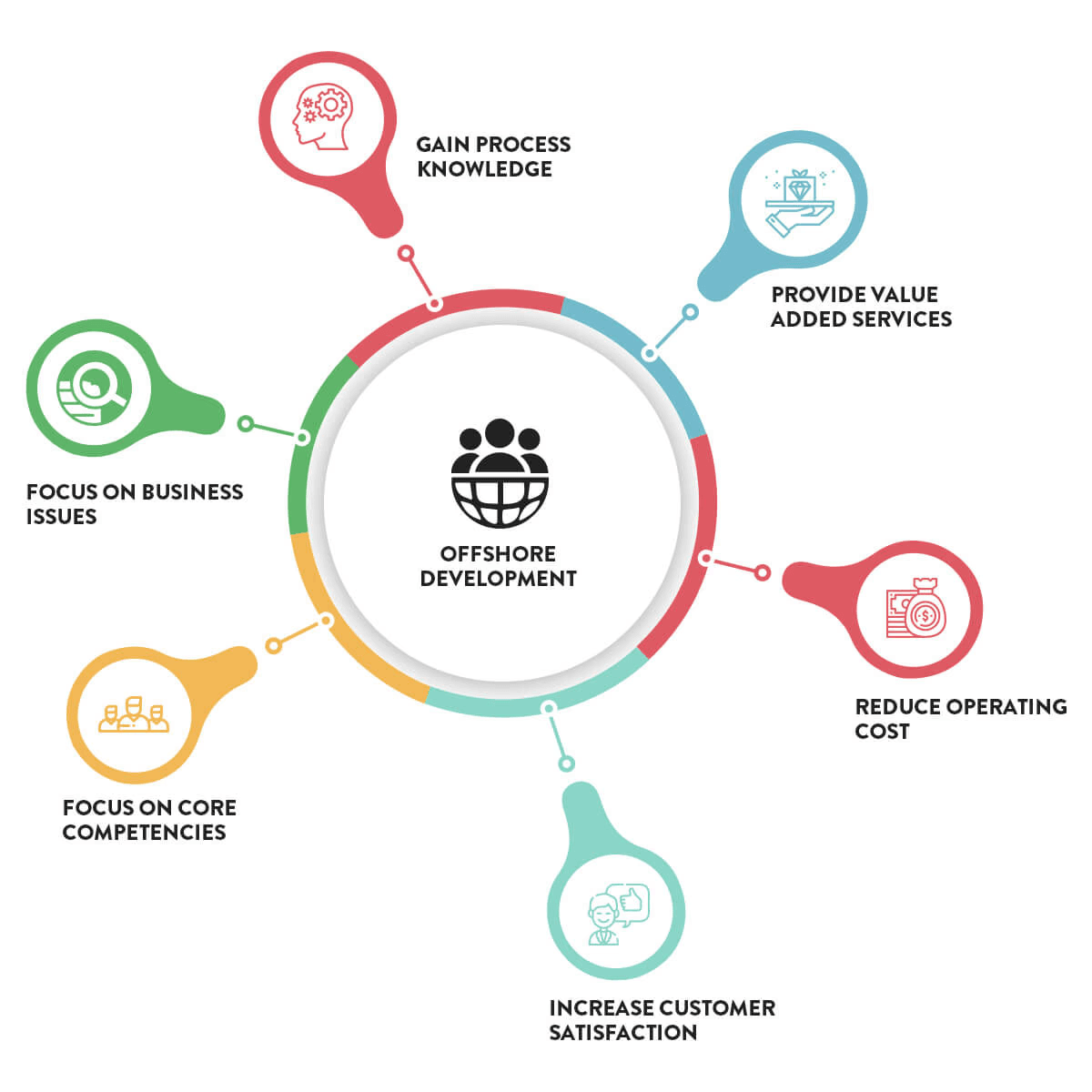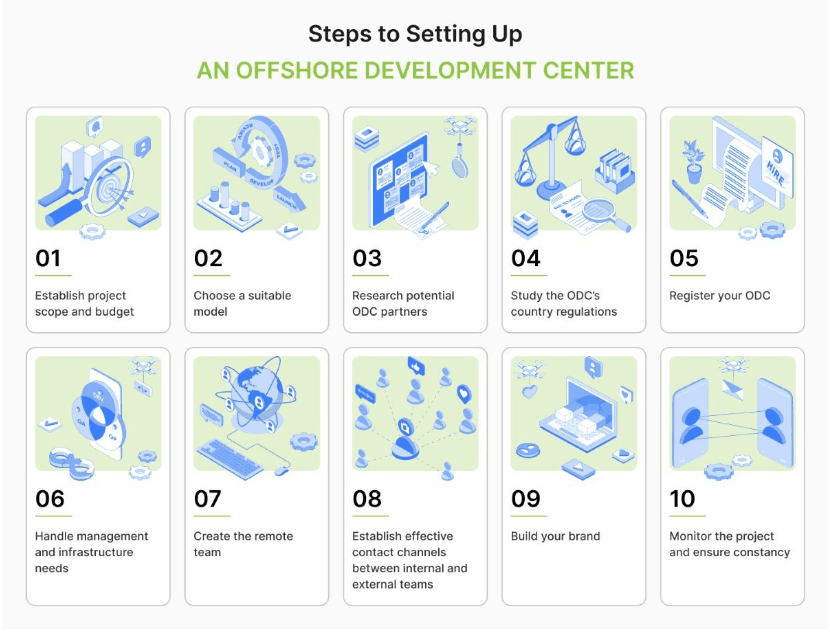Software development has become a basic requirement for running a business now.
Many enterprise owners are looking to move their projects to third-party development service providers so that their internal teams can focus on core business activities.
That’s where the Offshore Development Centers start to matter.
If you work in the IT sector, you may have heard about ODCs. For those who don’t know what an ODC is, the model is widely used when companies set up offices abroad to reduce operational costs and hire local talent.
Both startups and large enterprises favor this approach for establishing a global presence, accessing talent worldwide, capitalizing on foreign policies, and ensuring business survival.
Since the concept of ODC is by and large, a great concept, this guide will explore the importance, benefits, and steps involved in setting up an ODC, covering everything you need to successfully establish an office in another country.
What is an Offshore Development Center?

Setting up your own offshore software development center means creating a separate location abroad for your company’s development needs. It includes a diverse team, necessary infrastructure, office supplies, and managed processes essential for completing software projects.
Operated under the same brand and rules as your main company, the offshore center aligns with your business goals just like local teams do. Its main aim is to offer flexible tech resources while cutting costs, particularly in infrastructure expenses.
You oversee the offshore center directly, usually through a project manager who links business leaders with the offshore team handling project execution.
Team structure varies based on project needs but typically includes roles like project managers, software engineers, experts in back-end and frontend development services, QA testers, UI/UX designers, and administrative staff.
Companies needing strong data security, handling large projects, scaling operations, or cutting costs find offshore centers beneficial. They suit firms needing specialized skills or focusing on core business growth while outsourcing development tasks.
Offshore centers benefit any business, from software and eCommerce to fintech and IT firms, by affordably providing access to skilled professionals. They facilitate rapid scaling and are ideal for global expansion efforts.
How is it Different from Outsourcing?
Offshore Development Centers and software outsourcing differ in their approach: ODCs operate as extended offshore branches providing a range of services or products from another country, to reduce operational costs.

In contrast, outsourcing focuses on specific tasks or products sourced from third-party providers, regardless of location, to enhance productivity and manage costs. Both models leverage global talent pools to streamline operations, improve efficiency, and achieve cost savings across various business functions like development, testing, and client-specific ODC setups.
Let’s understand the differences based on a few factors!
Scope of Work
An Offshore Development Center typically handles broad, long-term initiatives, while outsourcing involves specific tasks or projects.
Cost
Offshore Development Center has more upfront investment in infrastructure, labor, and management whereas outsourcing has comparatively lower upfront costs with a pay-per-service model.
Work Location
Offshoring only happens internationally, while outsourcing can be local or global. Offshoring is usually international outsourcing, but not always. For example, IBM can offshore work to its Indian offices. Since the work is done within the same company, it’s offshoring, not outsourcing.
You may also like to read: The Complete Guide to Outsourcing Software Development in India
Benefits of Offshore Development Center Services

Cost Effectiveness
Expanding software development often faces cost pressures. According to Accelerance, offshore development teams can save companies between 39% and 72% compared to onshore teams in Seattle, Washington. Offshore locations benefit from lower living costs, leading to reduced labor expenses. Infrastructure costs like office rent are also lower. Additionally, some places offer tax incentives to tech sectors, further lowering overall expenses.
Global Talent Accessibility
Certain regions like America, Europe, and Asia have become popular epicenters for offshoring and outsourcing, attracting skilled IT professionals in masses. Companies set up offshore development centers in these areas to directly access these experts. Business leaders can build software teams with advanced skills in cutting-edge technologies to meet evolving demands.
Some companies opt to partner with existing ODCs instead of establishing their own. These partners provide professionals with the necessary skills and ensure the offshore team adheres to international standards, delivering high-quality work.
Better Scalability
Offshore Development Centers offer flexibility for organizations facing varying demands. They can quickly adjust team size and resources based on project needs, whether scaling up for growth or scaling down during quieter periods. This agility helps businesses efficiently manage resources and adapt to changing operational demands.
Business Continuity Assurance
Business continuity for an offshore development center means how well it can keep essential operations running despite disruptions like security breaches. Each team member acts as an extension of the main team and follows risk management protocols set by the parent company.
If the parent company struggles with a setback or disruption, tasks can be delegated to the offshore center. With their extended work hours due to time zone differences, the offshore team ensures ongoing project development, supporting continuous operations.
Enhanced Risk Management and Security
Compared to outsourcing, an offshore development center offers the strongest advantages in security and risk management. This model allows full control over security protocols, including physical and data security, regulatory compliance, and ensuring consistent business operations and quality.
You can set specific network security standards, establish local infrastructure with personalized risk management procedures, and more. If your security and compliance needs can’t be met offshore, despite cost benefits, an ODC might not be the right choice.
Local Expertise Utilization
If you’re expanding your business to a new market where your offshore development center is located, its team can help you adjust:
- Customizing your product for local needs
- Researching the market and users
- Adapting product design to fit local preferences
Continuous Operations Coverage’
As part of your team, an offshore development center can take over tasks when your local team finishes work, ensuring operations run smoothly day and night. This speeds up the launch of new features or products.
Continuous coverage is also useful for maintenance and support tasks assigned to your ODC. They can handle these tasks continuously. Moreover, the ODC team can quickly address security issues and keep essential functions running smoothly.
Complete Control
In a customer-owned dedicated offshore development center, you have total control over all aspects of its operations. This means you can customize it to fit your specific needs, from security protocols and compliance to maintaining high output quality and efficient communication.
Similarly, in a company-owned ODC, you still benefit from this control. The difference lies in the vendor managing tasks like communication and quality control processes, which can be a relief for companies looking to streamline operations and focus more on core tasks.
Easy recruitment and Management
If you choose to hire offshore developers directly to build a remote team, you’ll need to invest time and money in recruiting both developers and administrative staff. You’ll also need to set up the necessary infrastructure for them to work effectively.
On the other hand, partnering with an offshore development service provider means they handle the heavy lifting. They’ll screen specialists’ skills (though you can still make the final hiring call), manage daily operations, and ensure compliance with local laws. This saves you from studying tax codes or dealing with HR problems in an offshore location.
Popular Offshore Development Center Models
Since there are various models of offshore development centers based on the circumstances and business objectives, the most widely used are:
Dedicated ODC
this setup, a dedicated offshore software team works exclusively for one client. The team focuses solely on the client’s project needs, with infrastructure tailored to their requirements. This model is ideal for projects needing consistent control, customization, and close collaboration with a dedicated development team over the long term.
Project-Based ODC
In this approach, ODCs are set up specifically for defined projects with clear scopes, timelines, and deliverables. Once the project concludes, the ODC can be downsized or redirected. This model suits short-term projects with specific needs, where temporary specialist skills are needed without long-term obligations.
Hybrid ODC
In the hybrid model, aspects of both dedicated and project-based models are combined. A core team remains dedicated to the client within the outsourcing service provider, offering stability. Meanwhile, additional resources can be scaled up for specific project needs. This model is ideal for projects with ongoing maintenance and occasional specialized tasks, providing flexibility while maintaining a stable core team.
Must Read: 9 Main Challenges For Offshore Outsourcing
Challenges of working with an ODC

Language and Cultural Differences
When setting up an offshore development center, both the parent team and the offshore firm may encounter communication challenges and cultural differences, depending on the chosen location. Effective communication channels, competent project managers, and personal interaction from business leaders help bridge these gaps. Choosing a location with a similar culture can also mitigate language barriers and differences in work culture, ensuring smoother collaboration and decision-making processes.
Quality Control
Managing quality in remote team environments requires robust processes. Companies should implement thorough quality control measures, including training, audits, and regular inspections. Establishing specific quality assurance standards for each project ensures consistent quality. This proactive approach helps maintain control over the development process and ensures that deliverables meet or exceed expectations, despite the challenges of remote collaboration.
IP Protection and Data Security Risk
IP protection and data security are critical for any organization, especially when offshoring. Data breaches due to weak policies can severely impact business. Reputable offshore partners mitigate these risks by signing NDAs, conducting regular security audits, and maintaining robust infrastructure. Additionally, organizations can create local databases for backups to safeguard ongoing work and ensure data integrity.
Productivity Challenges
Organizations may encounter issues with offshore team performance and quality, leading to project delays. To avoid this, they should partner with an offshore development team that participates in the entire hiring process, ensuring the selection of suitable candidates. A reliable offshore partner offers transparent hiring and constant monitoring, helping to deploy projects faster and addressing productivity challenges effectively.
Management Challenges
Organizations often face management issues with offshore teams, such as poor customer focus, collaboration problems, and inadequate systems. Effective communication with the offshore partner is essential to clarify requirements, processes, and documentation. Evaluating the partner’s systems and work processes is crucial. Hiring from a reputable staff augmentation partner can help quickly adjust the team size and skills to meet project needs.
Also read: Top Reasons Why Companies Outsource Software Development
How to Set Up an Offshore Development Center

Define Needs, Goals, and Budget
Before developing your offshore development center, it’s important to understand the required work and budget. Estimate your project’s budget to choose the best business partner model.
You can also use AI charts for PowerPoint to present your financial estimates and resource planning in a clearer, more engaging format.
We’ll cover partner models later, but for now, focus on determining the size of your project and team. Remember, you can’t manage what you can’t measure.
Select a Suitable Model
This is where you choose the best offshore development center model for your needs. We’ll explain each model in detail later. The model you select will depend on your resources, budget, and project duration. Options include build-operate-transfer, staff augmentation, and others. Once you pick the right model for you, you can move on to the next step.
Research Potential ODC Partners
With your scope, model, and budget ready, start researching potential ODC partners. Ensure they meet your technical requirements and other project needs. Reach out to suitable companies and ask questions about their processes to find the best fit.
Study Country Regulations
Once you find an ODC partner you’re happy with, do not take the decision right away. Research the country’s laws related to your project to ensure it’s a viable option. Your ODC partner can assist with this information too.
Register Your ODC
With everything in place, you can register your ODC in the chosen country. This involves submitting signed documents with essential information to the state authorities. It may seem like a lot of official documentation, but you need to complete this step before moving ahead.
Manage Infrastructure and Operations
After registering your ODC in the country, you can move forward with managing its infrastructure. This includes researching and preparing everything your new facility will require. Start setting up the necessary technology, software, and resources for your future team.
Build the Remote Team
At this stage, you can collaborate with your ODC partner to build your remote team. The approach depends on the model you chose earlier. If you opt for staff augmentation, you’ll add team members to your existing staff. If you choose a dedicated offshore development center, you’ll work with the ODC company to determine which employees will be assigned to your project.
Set Up Effective Communication Channels
Communication is vital in the offshore industry. Use video conferencing tools and project management software for real-time team collaboration. Ensure secure data transfer with encrypted communication and comply with data protection laws to keep your information safe.
Promote Cross-Cultural Understanding
Encourage better understanding between teams from different cultures by bringing them together. Consider cultural sensitivity training to address any communication challenges that may arise.
Monitor Project and Ensure Consistency
Monitoring the success of your project is essential throughout its development and even after it’s completed. It’s important to keep the ODC team involved in ongoing maintenance and support. Alternatively, ensure a smooth handover so your team can manage maintenance needs effectively.
Your Ultimate Guideline/Checklist for Running an ODC
Here’s a checklist to ensure the success of your future ODC:
- Research the market and living standards of the country where you plan to establish your ODC.
- Plan the necessary facilities.
- Register your business as a legal entity with the local government.
- Find and lease an office space. Consider a central location or near a riverfront if the budget allows.
- Design the interior of the office.
- Complete any needed office renovations.
- Purchase and install furniture.
- Set up workstations and ensure internet connectivity.
- Implement a security system.
- Equip the office with necessary tools like printers, scanners, and software.
- Stock the pantry with snacks, water, coffee, and a first aid kit.
- Provide hardware and software tools for developers’ work.
- Procure all required office equipment and supplies.
Now focus on building your team:
- Hire key team members:
- Recruiter
- HR manager
- Accountant
- Lawyer
- Developers
- Additional staff for daily operations
To inspire and unify your team, consider:
- Establishing your brand identity and office culture.
- Implementing office branding to reflect your company values.
- Providing branded items like T-shirts, cups, pens, and notebooks based on your budget and growth aspirations.
These factors strengthen team bonding and boost employee commitment and job satisfaction.
Once your team is prepared to begin work, it’s important to:
- Coordinate corporate and cultural events with the HR Manager.
- Organize team-building activities and social gatherings like pizza parties.
- Establish a comprehensive benefits package for your employees.
- Schedule visits to engage with your team at the right times.
These steps contribute to encouraging loyalty among your talented workforce.
Payment and Billing Models for ODCs
Time & Material Model
This model is ideal when project scope and requirements might change. Clients can adjust resources as needed, adding or removing them based on project demands. Payment is based on the actual time and effort developers spend on the project.
Fixed Cost Model
This approach is ideal for small to medium-sized projects with specific goals and clear budgets. Costs and timelines are agreed upon upfront, ensuring clarity for clients who pay a fixed amount for the project’s completion.
Dedicated Resources Hiring
This model is ideal for long-term projects with uncertain scope and requirements. Clients get an entire team working exclusively on their projects. They pay a monthly fee that covers each team member’s salary and the outsourcing provider’s administrative and infrastructure costs.
Mistakes to Avoid while Setting up Your ODC
An offshore software development center can be financially rewarding for taking your business to greater heights, but it can also cause concerns if you don’t consider important factors.
Here are some common mistakes to watch out for:
- Not having clear long-term goals
- Only focusing on reducing costs
- Overlooking the benefits of a diverse workforce
- Choosing the wrong offshore development partner
- Not setting up effective communication tools and channels
If you want to avoid such mistakes and hire an Offshore Development Center in a hassle-free manner, then the following section is exclusively for you!
Choose the Right Offshore Development Center – DianApps
Being a professional custom software development company, we provide a range of services including hiring developers and specialists for marketing, sales, and social media. The core development services at DianApps include mobile and website development services, blockchain, AR and VR, Salesforce, IoT, and consulting.
Why Choose Us?
- Clear and Frequent Communication
- Experienced Software Developers
- Robust Security Protocols
- Positive Testimonials from Our Clients
Setting up and running a development center with DianApps is a hassle-free and straightforward process.
Conclusion
Setting up a dedicated offshore development center, whether managed by the customer or a contractor, helps organizations enhance their development capabilities at lower costs. It’s ideal for companies needing scalability, advanced data security, advanced tech skills, deep involvement, and long-term project support.
However, it’s crucial to understand legal obligations upfront and invest in infrastructure and team recruitment. An ODC partner like DianApps can streamline this process. If you’re looking to hire custom software development services from an ODC, reach out to DianApps experts for assistance in making this setup smooth and effective for your business needs.










Leave a Comment
Your email address will not be published. Required fields are marked *